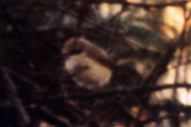
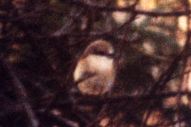
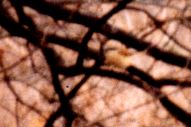
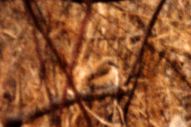

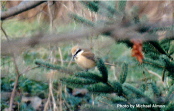
These photographs will certainly not win any awards, however, for those readers who are interested in the Brown Shrike (Lanius cristatus) that has appeared in Nova Scotia, here are a half dozen images which I have taken.
Athought there aren't a lot of details visible in these pictures, I think they nonetheless clearly establish the identity of the bird. Clearly visible is the eye patch which extends from the base of the bill across the ear coverts; the broad and white supercilium; the russet flush to the breast and belly; and the relatively dense russet-brown of the mantle (in comparison to the crown). These are all characters that help to distinguish the Brown Shrike from the Isabelline.They incline one to believe that subspecific identity of the bird was Lanius cristatus cristatus.
Selecting several of the images will show a larger version of the photograph.
All photographs © Christopher Majka.
It is also a very rare vagrant to Britain, Denmark, and (November 26, 1999) Ireland (1 record from each country), it might also be possible that the bird came from the east across the Atlantic. L. c. cristatus also breeds west to the Yenesi River in central Siberia. This area is some 10,600 km (again as the shrike flies) from Halifax, marginally closer.
The only North American specimen, an immature collected at Shemya I., Alaska, Oct. 10, 1978 was attributed to the subspecies L. c. lucionensis by Gibson (Condor 83:65-77, 1981). This is the southernmost of the four subspecies of Brown Shrike (breeding in Korea and the southern half of China) and would therefore be the least likely to be expected in North America. There is some suggestion that this specimen should be re-examined as to subspecific status since it was a juvenile, notoriously difficult to place.
Another of the half dozen North American records, an individual that wintered at Olema, California 28 November 1986 to 26 April 1987 (Small 1994, "California Birds, their status and distribution") was attributed to the L. c. cristatus/L. c. confusus group. L. c. confusus breeds around the Sea of Okhotsk and in the Amur River areas of both Russia and China, south of the range of L. c. cristatus. The fourth subspecies, L. c. superciliosus is found breeding on Japan and Sakhalin Island.